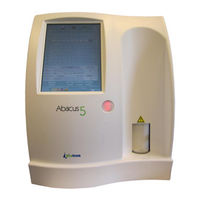
Diatron Abacus 5 Manuals
Manuals and User Guides for Diatron Abacus 5. We have 1 Diatron Abacus 5 manual available for free PDF download: Operator's Manual
Diatron Abacus 5 Operator's Manual (165 pages)
Brand: Diatron
|
Category: Laboratory Equipment
|
Size: 7 MB
Table of Contents
-
-
-
-
-
-
Front Panel35
-
Back Panel36
-
-
-
-
-
-
-
Manual Mode63
-
-
-
-
Warnings82
-
-
Statistics91
-
13 Patients
104 -
-
Types of Users106
-
-
15 Settings
110-
External Devices111
-
System Settings112
-
Units114
-
Printer Settings114
-
X-B Settings116
-
User Settings117
-
-
Log122
-
Reagent Status123
-
Statistics124
-
Information124
-
17 Maintenance
126 -
-
-
Dilutor Errors144
-
Priming Problems145
-
22 Appendix
148-
Display Ranges149
-
Fluidic System150
-
Specifications155
-
-
Precision157
-
Accuracy157
-
Linearity157
-
Carryover158
-
Sample Stability158
-
Mode to Mode158
-
Reference Ranges158
-
-
Reagent System161
-
Diluent161
-
Lyse Reagent 1161
-
Lyse Reagent 2161
-
Cleaner161
-
-
Tab File Format162
-
21 Accessories
148 -
23 Index
163
Advertisement
